My recent cruise down the Snake and Columbia Rivers retraced some of the steps of the 1804 Lewis and Clark Expedition. Also called the Corps of Discovery Expedition, they were sent to explore the area of the new Louisiana Purchase (link) and the region west of it to the Pacific Ocean. The Expedition has grabbed the imagination of people for two centuries now, as they imagine being in a small corps of men (and one woman) going into unknown regions. The Expedition walked, rode, and boated for over 8,000 miles in under three years, roundtrip.
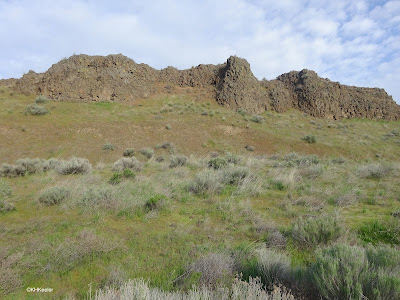 |
| Crow Butte, Washington |
Looking in detail at the discoveries of the Expedition is a reminder of how much the United States didn't know in 1800.
North America has two major geographic regions, East and West. These have many different plants and animals. The transition takes place at about the 100th meridian, which runs through central North and South Dakota, central Nebraska and Kansas, western Oklahoma and central Texas. Certainly by the time you reach the foothills of the Rocky Mountains, you are in the western region.
We forget how different East and West are because we have movies and television that show us the other region, because we have introduced all sorts of plants and animals from one region into the other region, and because many of us are not very in tune with nature. Today, there is a major shared urban and suburban culture that grows plants from all over the world, watered if necessary, so that where we live looks pretty similar from New York to Los Angeles.
But 1804 was before that. President Thomas Jefferson, who sent the Corps of Discovery west, knew ground hogs but not pronghorns, magnolias but not sagebrush, cardinals but not magpies. (For tribes west of the Missouri, it was the reverse.)
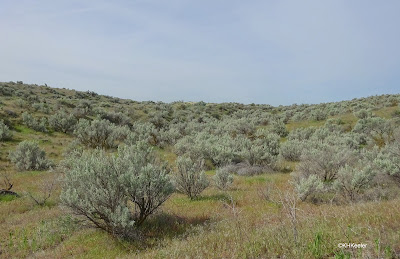 |
| Grassland with big sagebrush, Artemisia tridentata |
For people living in the West, the discoveries of Lewis and Clark are dull, because those plants are all around them. In the East, you may still not have seen big sagebrush or arrowleaf balsamroot.
Here, then, are some of the plants of the West that Lewis and Clark discovered for eastern North America.
Big sagebrush, Artemisia tridentata. North America has more than 40 native species of Artemisia, almost all found only in the West. Some are very common and big sagebrush is an ecosystem dominant over much of the region west of the Rocky Mountains and east of the Cascades (the Great Basin). (See also photo above).
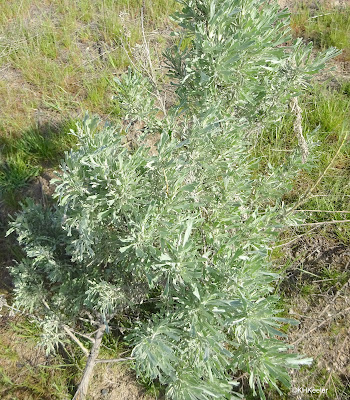 |
| big sagebrush Artemisia tridentata, from above |
In full bloom while I was along the Snake and Columbia Rivers, early April, was arrowleaf balsam root, Balsamorhiza sagittata. This is a sunflower relative with flower stalks to almost three feet tall and foot-long pointed leaves. You couldn't miss it. It is big for a flower of early spring. For days I saw it but couldn't get anywhere near it because it was blooming on steep slopes well above the river. It was a Native American food plant, the leaves were eaten raw or cooked and the seeds ground into flour. Clark noted Natives gathering it in his journal. Wildlife eat it too. This would be a spectacular early-spring native to grow, if it was native where I live.
 |
| arrowleaf balsamroot, Balsamorhiza sagittata |
Lomatium, called biscuit root and desert parsley, is a western genus of over 70 species in the United States. Lewis and Clark discovered five species. In the carrot and parsley family, Apiaceae, the lomatiums were major food plants. Patrick Gass of the Expedition wrote on April 15, 1806, "Here we got some Shap-e-leel [Lomatium], a kind of bread the natives make of roots, and bake in the sun; and which is strong and palable." (quoted in Dalton p. 77). Hence the name, biscuit root.
 |
| Lomatium |
Cacti, endemic to the Americas, are a largely a western group found in drier climates. Lewis and Clark encountered them repeatedly. Some species are easily trod-on, avoided, or ignored, but several were very troublesome. They encountered and distinguished at least three species of prickly pear, Opuntia. Most prickly pear cacti have spines formidable enough that you don't want to touch them. The brittle prickly pear, Opuntia fragilis, in particular, disperses by breaking off from the parent plant and sticking its spines into the feet of passing animals, to drop off somewhere else and root. That probably doesn't bother the hooves of bison very much, but it was very painful for explorers in mocassins. (Article on Opuntia in the Expedition link p. 13.)
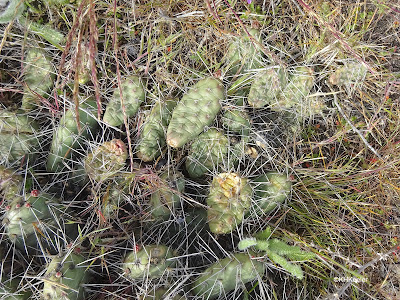 |
| brittle prickly pear, Opuntia fragilis, in western Washington |
Bitterbrush (Purshia tridentata) was collected by Lewis in Montana July 6, 1806; the herbarium specimen still survives. Purshia is a genus of five species all endemic to the American West. A member of the rose family (Rosaceae), it has pretty yellow flowers. Deep-rooted and drought tolerant, its foliage is high in nutritional value, making it important food for pronghorns, deer, and other wildlife, although the leaves taste unpalatably bitter to humans. It is one of the very few plants not in the pea family, Fabaceae, which has a mutualism with nitrogen-fixing bacteria in its roots and so, bitterbrush captures and exports nitrogen into the soil, allowing it to grow in very poor soils.
 |
| antelope bitterbrush, Purshia tridentata |
The plants we call Oregon grape (Berberis aquifolium previously Mahonia aquifolia, barberry family Berberidaceae) are also Lewis and Clark firsts. Oregon grape is now the state flower of Oregon. It forms good-sized woody shrubs, with bright yellow flowers in the spring followed by dark blue edible fruits (hence the name grape).
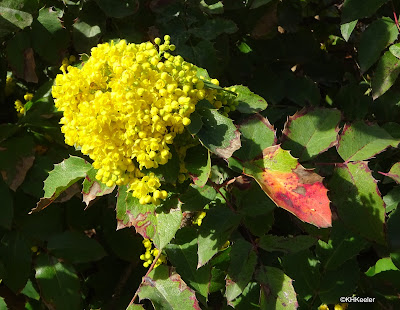 |
| Flowers of Oregon grape, Berberis aquifolium |
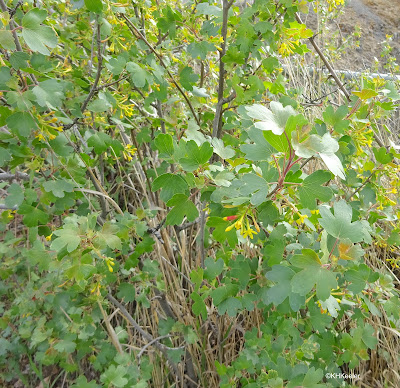 |
| golden currant, Ribes aurea |
New can be seen from the Native American view point as well. European Americans brought unknown animals and plants in the West. Native American languages had to scramble to find words for chicken, sheep, wheat, and apple, because these were alien organisms. They borrowed words from other tribes, from trappers and traders, from settlers. It is easier to find comments on Native reactions to European animals and plants, but East Coast organisms like pecans (Carya illinoinensis) and periodic cicadas (Magicicada) were also unknown.
The regions of North America remain, despite all the plants and animals we have transplanted.
Comments and corrections welcome.
References
Dalton, D.A. 2008. The Natural World of Lewis and Clark. University of Missouri Press, Columbia Missouri.
Faust, R and P. Faust. 1999. Wildflowers of the Inland Northwest. Museum of Northern Idaho. Coeur d'Alene, Idaho.
Visalli, D., W. Lockwood and D. Ditchburn. 2005. Hancock House Publishers. Surrey, British Columbia.
Flora of North America link About the various species. Accessed 5/4/24.
USDA Plants Database link For distributions, especially. Accessed 5/4/24.

Another interesting book on the subject, which I'm currently reading after "following" L & C in South Dakota recently:
ReplyDeleteEarle, AS, and Reveal, JL. 2003. Lewis and Clark's Green World; the expedition plants. Far Country Press.